Blind date in the science classroom Inspire article
Biology and chemistry teacher Werner Liese talks to Marlene Rau about the challenges of performing science experiments with blind and visually impaired students.
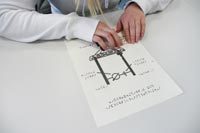
kind of paper which swells
up when combined with ink
and heat, for 3D
representations of diagrams,
such as this set-up for the
fused-salt electrolysis of
sodium hydroxide
Image courtesy of Dr Werner
Liese
Werner Liese is no ordinary teacher – and his students aren’t ordinary either. The day a friend invited him to sit in on a chemistry lesson he was teaching at the Carl-Strehl-Schulew1 in Marburg, Germany, changed Werner’s life. He realised that with his hobby – fiddling with electronics – he could make a real difference here.
Werner had just finished his training as a secondary-school biology and chemistry teacher and gained a PhD in inorganic chemistry at Marburg University, so he went straight to the school’s headmaster and asked for a job: he wanted to apply his skills to using and developing tools for blind and visually impaired students, to help them do experimental work in the science classroom.
Werner got the job, and over the past 29 years has been very successful as both a teacher and technical developer, and has brightened up numerous students’ lives.
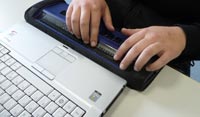
terminal to check the text she
has just typed on her laptop.
A Braille terminal is actually
more expensive than the
laptop itself
Image courtesy of Dr Werner
Liese
“It is so important that the students can do their own experiments. This not only helps them to understand the way scientists work – it is the only viable way to make even complex topics transparent for the students – otherwise they remain just theories. It makes all the difference.”
Today, the Carl-Strehl-Schule accommodates more technology than your average school: students take notes mostly on laptops; visually impaired students use digital enlargers to magnify the text they are reading; and blind students can scan in text, after which it is either read aloud to them by a computer or represented on a Braille terminal – an electro-mechanical device for displaying one line of Braille characters at a a time by raising pins on a flat surface.
When Werner started his job, things were very difficult. There was not a lot of technological support for his students, let alone for the science classroom. Many experiments had to be explained and the students had no opportunity to experience them first-hand. Shortly after he joined the school, Werner started developing electronic tools for teaching science to the blind and visually impaired. A full-time electronics engineer was employed to help, and a dedicated workshop was fitted for the task. “Not one teaching-materials supplier worldwide offers ready-made materials adapted for blind students – the market is just too small,” Werner states sadly. “I was very lucky that, for a time, the school relieved me of the majority of my teaching duties so that I could dedicate my time to developing these tools. This, and several generous grants made it all possible.”
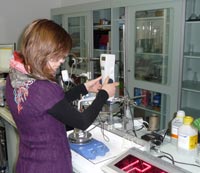
performs an acid-base
titration experiment with the
talking digital burette, using
the large LCD display
Image courtesy of Dr Werner
Liese
What special needs do his students have? “Of course it wouldn’t make sense to concentrate for weeks on end on the chemistry of coloured pigments in a classroom full of blind students. But basically, you can teach any science topic at our school, just as you can at any other. For grades 5 to 10, we have adapted the curricula to our students’ needs, but from grade 11 onward, they need to prepare for the general school-leaving certificate (Abitur), which enables them to go to university. The exam questions are the same for all students in the federal state, so our students need to learn the same material as their peers. We actually collaborate with other secondary schools in Marburg to offer joint courses for sighted and visually impaired students in subjects for which there are very few students.
“The main task for the teacher is to translate visual impressions into impressions our students can perceive with their other senses – mostly acoustic or tactile. Similar tools are employed in all sciences, but chemistry requires the most complex adaptations. For our visually impaired students, we use cameras with special optics to transmit details of the experiments to computer screens. With this the students are able to zoom in sufficiently to easily follow experiments being demonstrated by the teacher or other students. In our media centre and electronics lab, we design instruments that convert light or colours into sound or synthetic speech: students weigh out chemicals with special precision tools, and we fit standard measuring instruments with large digital displays and voice output.
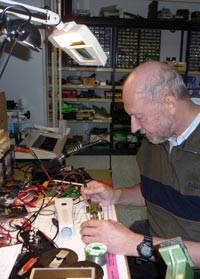
electronics lab at the Carl-
Strehl-Schule, developing the
interface for the talking
digital burette
Image courtesy of Sonja
Dörrich-Liese
“I had to learn a lot about analogue and digital electronics as well as computer-aided design to be able to tackle more complex projects, such as a digital burette which for the first time enables blind people to perform precise titrations. We fitted a standard burette with an electronic interface that sends the data to an adapter we built, which has a voice output and a very large display. Coupling the burette to a data-recording programme allows the students to produce not only tables but also graphical representations of the data. These can then be made available in tactile form by printing them onto ‘swelling paper’, a special kind of paper that swells up when combined with ink and heat.
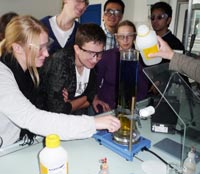
identify the colour change in
an acid-base reaction with
bromothymol blue indicator.
A strong light is shone
through the solution, and the
optophone sensor (held by
the blind girl on the left)
measures the incoming light.
As long as the solution is
yellow (acidic) and the
incoming light is strong, the
optophone emits a high-
pitched sound. When the
solution becomes basic and
turns blue, optophone will
emit a low-pitched sound.
The instrument can also be
used to measure electrical
conductance, emitting
differently pitched sounds
for different conductivity
values
Image courtesy of Dr Werner
Liese
“Many of the tools we have produced in our workshop are not available anywhere else. However, two of the instruments that we developed are also commercially available: a talking digital multimeter, and an ‘optophone’ – an instrument to measure light intensity and electrical conductance and translate this into sounds at different pitch.”
Another project Werner is particularly proud of is the LiTeX programmew2, which he has been working on over the past nine years; it is now the most comprehensive German-language writing tool for the blind and visually impaired. “It is a freely downloadable template for Microsoft WordTM which enables the simple integration of formulae, equations, structural formulae and Lewis notation for maths, physics and chemistry, and offers a number of important help functions for writing normal texts which weren’t available before. Even many sighted people find it useful.”
Werner is also active outside the school walls. When his former PhD supervisor founded the Chemikumw3 teaching lab at Marburg University, Werner was called in to develop experiments and adaptations to enable blind and visually impaired people to use the lab. This experimental chemistry lab is open for anyone aged four and above – school classes, groups or individuals – to attend demonstrations or take part in hands-on experiments.
This project fulfils Werner’s ambitions for science education: “Anyone can enjoy science. But it is extremely important for teachers to be creative in their use of equipment. This is true not only at a school like ours, but in any classroom. Besides, he or she has to be enthusiastic and transmit this enthusiasm to the students.” Werner’s students demonstrate his success – one of his former students, a blind boy, has graduated in biology at Marburg University, while another visually impaired student has successfully completed a PhD in chemistry. Werner has achieved his goal: he has made science more accessible to everyone – including the blind.
The Carl-Strehl-Schule
The Carl-Strehl-Schule is the only school for blind and visually impaired students in German-speaking countries that provides secondary-school education beginning as early as grade 5 (aged 11). To cover such a large geographic area, it needs to be a boarding school. It is part of the German Institute for the Blind (Deutsche Blindenstudienanstalt)w4 which also offers training programmes for blind adults, a library of Braille and audio books, and a publishing house for Braille books.
The institute was founded in 1916 to cater for the many young men who had lost their eyesight in World War I. Today, the school’s 300 students, who are taught in small groups of eight to twelve students, arrive at various ages and for different reasons – some have been born blind or visually impaired, others lose their eyesight gradually due to a disease, while others have had an accident.
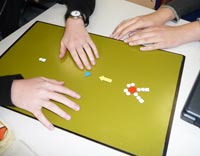
students at the Carl-Strehl-
Schule use magnetic boards
for Lewis notation and
studying chemical reactions,
such as the reaction of
sodium with water
Image courtesy of Dr Werner
Liese
The Carl-Strehl-Schule has a range of secondary-school branches. After grade 10 (at the age of 16), students can choose three years of general education leading to the Abitur, which qualifies them to study any subject at university. For these students, the school offers an optional detailed course in economics. Alternatively, students who want to study sociology or economics at a technical university (Fachhochschule) can spend two or three years focusing on these subjects.
In addition, the school offers two-year full-time vocational courses to prepare their students for a range of jobs in IT or as foreign-language secretaries.
The Carl-Strehl-Schule also offers advice and practical help for blind and visually impaired students at other schools.
Outside the classroom, students can choose from a variety of extracurricular activities, such as acting, a choir, a rock band, horse-riding, football, judo, swimming, athletics, gardening, excursions to watch and listen to bats, or participation in the environmental club which has installed solar and cogeneration power plants in the school.
Web References
- w1 – Find out more about the Carl-Strehl-Schule on the school’s website (in German): www.blista.de/css
- w2 – The LiTeX programme is freely available on Werner Liese’s website, which also contains more information about Werner and his work (in German): www.werner-liese.de
- w3 – The Chemikum Marburg offers anyone aged four and above the possibility to do chemistry experiments (in German). See: www.chemikum-marburg.de
- w4 – Learn more about the German Institute for the Blind (Deutsche Blindenstudienanstalt) here (in German): www.blista.de





